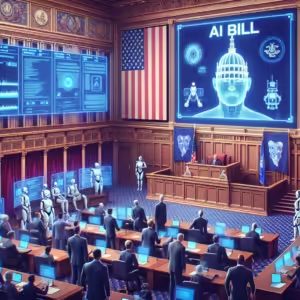The Impact of Tariffs on America’s AI Sector
In the rapidly evolving world of technology, few areas are as promising and transformative as Artificial Intelligence (AI). The United States, particularly Silicon Valley, has been at the forefront of AI innovation. However, recent developments in trade policies, spearheaded by the previous administration, threaten to slow down this progress. How could tariffs imposed under the Trump administration affect the burgeoning AI sector in America? This article delves into the potential repercussions and why it matters.
Understanding the Trade War and Its Targets
The trade war launched during the Trump administration primarily targeted China, one of the world’s leading technology hubs. The tariffs imposed on Chinese goods aimed to rectify what was perceived as unfair trade practices. Unfortunately, these measures also ensnared critical components essential for AI development.
Key Components Affected by Tariffs
AI technology thrives on a vast array of sophisticated hardware and software. Here are some critical components impacted:
As these components become subject to tariffs, costs inevitably rise, putting pressure on innovation and development within American borders.
The Potential Impact on Silicon Valley
Home to leading tech giants and startups, Silicon Valley could face significant setbacks due to increased production costs.
Challenges for Startups
– **Increased Expenses**: Startups, often operating on limited budgets, may find it challenging to absorb these added costs, potentially slowing growth and innovation.
– **Investment Uncertainty**: Financial backers may become wary of investing, leading to either funding stagnation or a shift of capital towards less affected regions.
– **Competition**: Startups in countries not hampered by such tariffs might gain an edge, drawing talent and investment away from the US.
Impact on Larger Tech Companies
Even for tech giants, these tariffs could lead to sizable disruptions:
– **Supply Chain Adjustments**: Major players might need to shift their supplier base or relocate production facilities, both costly and time-consuming efforts.
– **Loss of Market Share**: As operational costs increase, these companies might pass expenses onto consumers, potentially losing market share to global competitors.
– **Slower Innovation Cycles**: The increased costs could mean less capital is available for research and development, delaying cutting-edge product releases.
Broader Implications for the AI Revolution
A stagnation in America’s AI capabilities poses broader implications beyond Silicon Valley, affecting the nation’s standing in the global tech landscape.
National Security Concerns
AI is not only a commercial asset but also crucial for national security. Any delay in American AI advancements could put the nation at risk of falling behind adversaries who continue to progress unhindered.
Economic Repercussions
– **Job Market Effects**: As AI growth slows, so does job creation in this high-potential sector. The talent pool may seek opportunities abroad, leading to a potential brain drain.
– **Reduced Competitiveness**: The US could lose its competitive edge in AI, surrendering ground to other global tech hubs that are not stifled by similar tariffs.
The Call for Policy Review
To ensure that America remains a global leader in AI, a reassessment of current trade policies is crucial. This involves considering how tariffs impact the entire tech ecosystem and seeking more balanced approaches that protect American innovation while addressing trade discrepancies.
Potential Solutions
– **Strategic Partnerships**: Building alliances with countries excelling in tech can help mitigate some of the trade war’s impacts through collaborative innovation.
– **Incentivizing Local Production**: Encouraging domestic manufacturing of critical components could reduce dependency on imports, albeit at a significant upfront investment.
– **Policy Reforms**: Revisiting and reforming trade policies to strike a balance between protectionism and global trade engagement could stabilize the AI sector’s future.
Conclusion
The imposition of tariffs under Trump’s trade war poses a distinct challenge to America’s dominance in AI development. Silicon Valley, as a crucial player in this field, might experience slowdowns that ripple across national security and the economy. Ensuring that America stays at the forefront of AI technology demands a careful reevaluation of trade strategies to foster innovation without compromising competitive advantages. By addressing these challenges head-on, America can continue to lead the charge in AI, securing its position in the future of technology.








